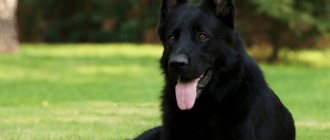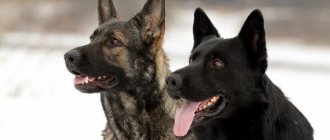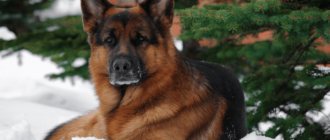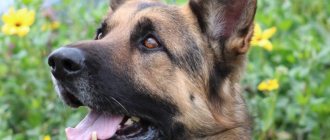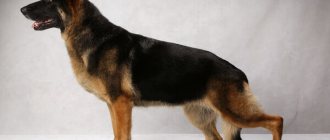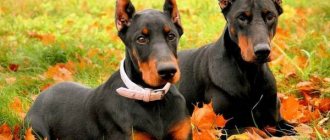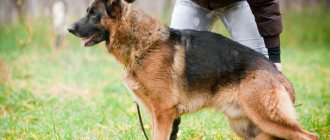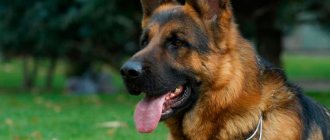As an independent breed, the German Shepherd began its history deep in the past. In Western European territories, skeletons of Bronze Age dogs were found that resembled the remains of a small Indian wolf. He became the progenitor of the German Shepherd living in our time. Based on these findings, it can be assumed that the “bronze” dog was due to the crossing of a wolf and a European dog. You will find out what the further origin of the German Shepherd breed is in this article.
Description of the German Shepherd breed
Popularity 5th among 263 dog breeds
Lifespan:
11-13 years old
Breed group:
Service
Height:
males: 60-65 cm, females: 55-60 cm
Country of origin:
Germany
Average price:
5-30 thousand rubles
Weight:
males: 30-40 kg, females: 22-32 kg
Latest articles Cat health
Ataxia in cats: what it is, how it manifests itself and is treated 01/23/2022 83 0 0
Cat health
Leukemia, or viral leukemia in cats 01/23/2022 68 0 0
Advantages and disadvantages
- Pros:
- have high intelligence;
- are capable students;
- quickly amenable to training;
- have a quick reaction;
- friendly, loyal;
- are naturally endowed with a lot of useful skills;
- do not show aggression for no reason.
- Minuses:
- hyperactivity;
- the need for frequent walks;
- not suitable for keeping in small apartments;
- without appropriate education they can be extremely dangerous;
- shed heavily;
- require constant attention and communication.
Key facts
The characteristics of the German Shepherd breed are as follows: they are large, strong and incredibly smart dogs with innate guarding, fighting and hunting skills. “Germans” are immensely devoted to their owner, very smart, and given proper upbringing and training, they are efficient and well prepared to perform dangerous tasks. These dogs are friendly and kind to others.
You can keep them in an apartment, but the best option for a pet is fresh air, plenty of space for movement, games, and training. They are very active, inquisitive and smart.
Dogs of this breed will be both excellent guards, “co-workers”, and excellent furry friends, protectors in the family. The most important thing for them is a person’s authority. They are ready to obey unquestioningly, learn, and carry out any commands. The process of training them goes quickly and clearly, because the “Germans” are one of the smartest dogs in the world. An important task for the owner is to start training and training as early as possible.
Interesting
: German Shepherds are wonderful actors, playing leading roles in action-packed films or luxury food commercials.
They do not provoke empty collisions with other animals; first they carefully study the surrounding environment and sniff. Of course, this behavior is achieved through hard training, strict education and the necessary attention.
Germans have a hypersensitive sense of smell. That is why they are used by dog handlers, various military intelligence services, military structures, and the police. They are naturally strong, fast and very agile.
Shepherds are truly incredibly active. It will not be difficult for them to run for hours after a stick or actively play all kinds of games. They need constant communication. For people who love regularity, calmness, or even passivity, this can be a huge inconvenience.
The description of the German Shepherd breed is based primarily on its working qualities. Therefore, the dog certainly needs constant attention from the owner. The lifespan of a German Shepherd depends on properly distributed physical and mental activity - without them, the dog quickly fades away.
Photos with examples of color variations
The standard includes 4 colors:
- Black – a classic color option. On the back, from the shoulders to the tailbone, a dark, triangular mantle stands out. The color may be deep or weakened. The lighter parts are called tan marks. They can be red, light brown, gray and yellow. The muzzle is covered with a dark mask;
- zonal - as archaeological excavations confirm, the zonal color is one of the most ancient, although it is not very common in our time. Each hair on an animal's skin is colored in ring zones: a light base at the root, a black stripe just above, a yellow hair at the tip and a black tip. The color may turn yellow or gray;
- black is a very rare color that occurs in approximately 3% of 100. Puppies with this color are highly valued among breeders. The dog's entire body is covered with black fur with a glossy sheen;
- black and tan - refers to standard colors only conditionally. Characterized by small areas of red on the cheekbones or eyebrows against an overall black background. The color is in many ways reminiscent of the Doberman Pinscher. Dogs with black and tan colors are not allowed to participate in exhibitions, but are actively used in working breeding.
There are also barely any colors - red and white . They have not been recognized as a standard, but are highly valued by breeders for their originality.
Black color:
Zonal color:
Black and Tan:
Black:
History of the origin of the German Shepherd
Archaeological research indicates that as early as the 4th century BC. e. In the places where Poland, the Czech Republic, and the former Austria-Hungary are located today, there were animals similar to modern shepherd dogs. They were tamed by humans, subsequently becoming protectors in primitive tribes. There is information that already at that time they began to engage in conscious breeding. This led to the improvement of the physical and mental qualities of dogs.
Gradually there was a separation of domesticated dogs from their wild relatives. Over time, people began to become more and more active in agricultural, economic, and hunting activities, settling in a certain area. And tamed animals fulfilled new roles: guards of livestock, protectors of people, game hunters, detectives, assistants. The so-called Hovawarts (translated from German as “court guards”) appeared.
The smartest, most intelligent, and dexterous yard dogs became companions of tribal hunters or guard assistants to shepherds. It was at that time that people began to purposefully engage in breeding, selecting the best qualities of different four-legged representatives. Then came death penalties for killing or harming “selected” breeds.
Of course, animals of the primitive, medieval, and other millennia had very few similarities with modern dogs. The main task of the first shepherd dogs was to constantly stay with the shepherd; they had to not only protect the shepherds, but become one, unquestioningly obeying, accompanying, protecting.
In the 17th century, two local species of Germanic dogs appeared. They became: long-haired Thuringian fawn-gray with a curled tail and Württemberg with long black or red hair with erect ears. The main differences concerned temperament and character. The former were active and often barked, while the latter were distinguished by their measured movements and general calmness.
Dog breeders have managed to breed the ideal breed, combining the best features of appearance and character. Towards the end of the 19th century, at a dog show in Hanover, Baron von Knigge showed people his two wonderful shaggy companions, males Greif and Kiras. Then other owners, the owners of the Hanau kennel, brought into the world strong, stately shepherd dogs: the male Palux and the female Primma. These events created a real sensation in the world.
In the 90s of the same 19th century, the first club for German Shepherd lovers was opened. And by the end of the century, a certain Hector von Lierkeinhain on the streets of Germany demonstrated to passers-by the skills of his favorite, endowed with the most perfect features. Max von Stefanets passed by, who, together with his friend Arthur Mayer, was breeding German shepherds. A week later, they persuaded the man to give the animal to them.
The ideal “German” was the first to be included in the breed book. A persistent search began for similar females. The efforts were not in vain: as a result, the breeder bred puppies with the desired characteristics.
During the 30-40s of the 20th century, many nurseries were destroyed and a large number of well-born pets were killed. They stopped monitoring the preservation of the standards of the remaining animals. At the end of the 40s, selection and breeding were restored. In the 1970s, the International Association “World Union of German Shepherd Associations” was founded, which includes 82 states.
First attempts at selection
Many people have tried to create a new breed of dog for guarding herds, with the same requirements for both character and appearance, but have failed. The popularity of herding dogs increased throughout European territory, which led to an increase in the number of livestock.
At the end of the eighteenth century, the shepherd dog became the most common breed in Germany. There were two places for breeding dogs:
- district of Württemberg, where large-built dogs with a calm character, thick long hair with a red or black tint, and hanging ears were bred.
- southwest of Thuringia, where shepherd dogs of medium build were bred, dynamic and angry, with a gray coat similar to a wolf's color and erect ears.
At the beginning of the nineteenth century, the number of livestock began to increase sharply, dogs from different parts of Germany began to be crossed, adding different herding dogs to the line of offspring, resulting in a huge variety of types of shepherd dogs.
The exhibition where shepherd dogs were shown for the first time took place in Hanover in 1882.
Appearance of a German Shepherd
Adult dogs have a fairly large body and a strong, muscular musculoskeletal frame. Despite their large body size, they look very cute. You can often see a photo of a German Shepherd sitting friendly next to small kittens - indeed, well-mannered dogs never show aggression, especially towards those who are smaller than them.
General impression
German dogs have large, expressive eyes, an inquisitive look, triangular ears, always a cheerful face with a smile and a funny hanging long tongue.
Head
The head is large, the skull has an elongated, wedge-shaped shape. The forehead is straight with a slightly convex central part. The transition from the forehead to the nose is smooth, smooth, with a small gap between the eyes.
Ears
Puppies are born with soft and floppy ears, but their setting should occur no later than 5 months.
If a six-month-old animal (or older) has soft ears, this is considered a defect. A shepherd's ears should be hard, erect, with sharp corners at the top. Unevenness and non-parallelism are not allowed.
Nose
The nose of a “German” should be straight and parallel to the frontal line. A Roman (humped) nose bridge is not allowed.
The lobe must be black, regardless of color. Duality is considered a marriage.
Teeth and jaws
The jaw is massive, very tenacious, strong. The mouth is wide, with white, sharp teeth and a long pink tongue.
Eyes
Large dark eyes are very expressive. They are located strictly proportionally. They are framed by a dark gray outline, similar to shadows. And there are even small black eyebrows near the bridge of the nose.
Neck
The neck is moderately long and very mobile. It has a wide diameter and is also covered with a mop of thick hair.
Torso
The physique is strong and fighting. The back is wide in the thoracic region, the chest itself is voluminous, the ribs seem to be elongated. The withers are quite massive, and the flowing croup smoothly passes into the beginning of the tail.
Forelegs
Strong, straight forelimbs positioned strictly parallel to each other. The elbows are in a straight position relative to the body. The shoulders meet at a 90-degree angle with slightly protruding shoulder blades.
Hind limbs
The hind legs are noticeably shorter than the front legs. They are rounded, slightly set back. The thighs and lower legs are of equal length, with an obtuse angle of approximately 120 degrees visible between them. The metacarpus of the four limbs are smoothly rounded, the fingers have a slight arch.
Tail
The relatively long tail is carried slightly upward. In a calm position, it is below the line of the spine. According to standards, it should be dark, black. There is quite a lot of fur on it, especially in the lower part.
Movements
The nature of the movements is sweeping. Quadrupeds move very actively, as if jumping while running or walking. They have a quick reaction, can pick up speed up to 50 km per hour, and climb heights 5-6 times their own height.
Wool
The coat is two-layered, thick due to the heavy, tight hair with a dense texture and voluminous undercoat. Petting your furry friend is a great pleasure.
Color
The exterior is based on a black shade with red, ash, and dark gray lines. Pure black or gray colors are allowed. The fur on the belly is lighter. The colors of the German Shepherd cannot be called varied, but they serve as a good identification mark of the breed.
Size
The average height of a male German Shepherd is 60-65 cm, the female is smaller, her height is about 55-60 cm. Similarly, the weight of a male German Shepherd (30-40 kg) exceeds the weight of a female (20-30 kg). Females look more graceful and slender. The size of the German Shepherd allows it to be kept in an apartment - but only in one where there is enough space for it.
Personality of the German Shepherd
Dog breeders and trainers praise shepherd dogs for their valuable qualities: deep loyalty, sharp intelligence, quick wit, and instant reaction. It’s impossible to list all the advantages. Under conditions of proper upbringing, the right approach to training and education, they grow into ideal family companions, dexterous fighters, and reliable helpers.
Dogs are not stubborn, but are always open to training and learning new commands. Most of all, they do not tolerate spending time alone: four-legged friends constantly need the caring attention of their owner or teacher, they love noisy, cheerful companies, and are ready to continually give their love and protect people.
By temperament they are closer to choleric people. Mobility, running, play, speed tasks are the main components of the excellent mood of such an active dog. The character of the German Shepherd is genetically based on developed protective instincts. Therefore, during walks, you should keep the shaggy beauty on a thick leash with a strong collar, and a muzzle is also required. The dog does not show aggression in vain, but sudden actions near him can provoke anger.
For the sake of their household, they are ready to make any sacrifice. By raising a puppy from childhood, you can be sure of his sincere devotion only to you, your family, and your close circle. With such a protector, calm, peace, and security in the home are 100% guaranteed.
A well-mannered “German” is careful with children. But you shouldn’t leave a small child alone with him. If a new pet appears in the house, the little friend will quickly get used to it, but an adult will treat it with great disapproval.
The difference between a bitch and a dog
Boys tend to be dominant and stubborn - this can cause problems during training. But people leading an active lifestyle prefer to have males, as they are more active and hardy than females. It is also better to choose male dogs for protection and escort - they are distrustful of strangers and in case of danger they will be able to confidently fight back.
Girls are softer, calmer and more flexible. They are much more trainable and become more attached to humans. And if boys are more suitable for service, sports and accompaniment, then girls are natural nannies, companions and guides. But bitches also have a minus - they can be cunning and insidious in a feminine way.
Keep in mind that the inclinations of a dog, the character of its parents, the upbringing and attitude of the person are of great importance. In the wrong hands, even a quiet female will become a real monster, and a good attitude and affection will turn a potentially aggressive male into an exemplary favorite.
It is worth taking into account that a male dog constantly experiences sexual desire, therefore, when he smells a dog in heat, the dog will suffer and be sad, and may even show aggression and refuse to eat for a long time. And on a walk, a guy can break off the leash and run to where he smells a bitch.
Girls during heat (which occurs 2 times a year) also begin to behave inappropriately: they can be stubborn, disobey their owner, and run away from home. During this period, the dog needs a special approach, but in no case cruel.
Attitude towards children
For a very young child (from birth to 3 years), it is better not to get a dog - especially a puppy, which also requires a lot of time and attention. But, if the German Shepherd already lived in the house before the baby was born, you need to follow several rules:
- limit the animal's access to the child's room - the dog should not go there whenever it wants;
- do not occupy the place that previously belonged to the dog with the child’s things: the pet may become jealous;
- carry out wet cleaning daily at least once a day: this will prevent the child from developing allergies;
- show the “German” the baby, let him smell his things so that the dog gets used to the smell;
- do not leave the child and the dog alone: be sure to be present during the interaction between the animal and the little person, closely observe the reaction and behavior of the dog.
Typically, properly trained German Shepherds do not harm children, even if they pull their fur or tail. But it’s better not to test the four-legged man’s patience – he may growl.
If the child is between 5 and 14 years old, then the question of whether they will get along with the dog depends entirely on the child and his parents. Explain to your child that a dog, especially a small puppy, is not a toy, but a family member who needs to be taken care of. Let your child understand that with the advent of a dog, your family’s life will change, and everyone should be prepared for such a turn of events.
“German” will become a wonderful friend for a child with whom he will play, run outside and play sports. Some shepherd dogs are even sent to meet children from school or section in the dark.
Relationship with other pets
If you socialize your German early and introduce him to your other pets, the dog will never harm them. The Sheepdog will protect its four-legged neighbors as well as people.
Difficulties may arise if you bring an adult dog into your home. In this case, it would be a good idea to hire a specialist to help your dog learn a few rules for safe cohabitation with other animals.
A well-mannered “German” who knows commands and respects his owner will not run into conflict with another dog, even if he is provoked. The dog will begin to attack another male only in a critical situation.
Owner reviews
Vladlen : “I want to warn those who are just thinking about getting a German Shepherd dog. The breed is not as romantic as they show in films about Commissioner Rex. Dogs carry dirt into the house, smell strongly, shed terribly, scatter gnawed bones throughout the house and can eat and drink sloppily. If that doesn't stop you, then get a shepherd! This is my second dog of this breed, I just adore Germans. They are smart, selfless and loyal. But choosing this breed should be a conscious and deliberate step.”
Anatoly : “For owners of private houses, a German shepherd can be an ideal breed. They are excellent guards and companions. Dogs have an ideal genetic memory for commands, but they need to be professionally trained. You won't be able to live with the Germans without training. The dog must be taught to obey its owner, not to pick up food from the ground, and not to attack without a command. They also need space and many hours of active walking.”
Elena : “When we got a dog, we thought for a long time what to name the puppy. We settled on Mary. In honor of Mary Poppins, the famous nanny. Our Mary is a wonderful nanny. She is already 10 years old. All the children grew up next to her. She looked after and protected each one as if she were her own child. The smartest creature. Sometimes it seems to me that she is smarter than a person. All the neighbors are in love with her. The dog is seasoned, affectionate and very sociable. Enjoys playing with our children and their friends. Protects them all. Doesn't allow strangers near children. Reacts to inappropriate behavior of strangers.”
Intelligence
The German Shepherd is considered to be one of the smartest dogs known to man. Poodles and border collies also share this title with the “German” - these dogs are among the three smartest.
Training for a shepherd is always a joy. She willingly learns new commands and performs tricks. This breed can memorize up to 20-30 different commands, and some “tailed geniuses” master over 50 commands. It’s not for nothing that “Germans” are often used to film films and TV series - they can fulfill any whim of the director.
Where is the best place to keep it?
Veterinarians and dog handlers are unanimous in the opinion that the ideal conditions for a shepherd dog are a spacious enclosure with an insulated booth .
This does not mean that a dog cannot be kept in an apartment. If you follow a walking regime and regular street training, the dog will feel no less great.
Education and training
Developed skills for quickly perceiving new information have been mentioned more than once. It is important to start raising an animal from early childhood. Even in puppyhood, one should not be allowed to act without permission, scratch a lot, chew things, or bite during play. Often kids quickly get carried away, starting to involuntarily strengthen their grip, without noticing it, tightly squeezing the person’s hands with their tenacious teeth. Starting from the first months of life, such behavior must be stopped.
After reaching four to five months, it is better to start taking your pet to professional trainers. The course of education and training of a German shepherd for a period of 15 months consists of 9 complexes. Understanding the authority of the owner is the main sign of a well-mannered animal. Without shouting, sudden movements, or anger, negative behavior or failure to comply with a certain command should be indicated. Professional trainers recommend becoming a commander for your furry soldier.
During walks, a six-month-old friend must be muzzled and know the basic commands: “Place!”, “Come to me!”, “Ugh!” An important fact is that “Germans” achieve full emotional awareness only at the age of three. Big, strong on the outside, the “shepherd” on the inside remains a puppy that requires a lot of attention and affection.
Looking for a German Shepherd? Find your pet from 12 offers As a gift
German Shepherd Health and Diseases
Possible diseases
On average, shepherd dogs live 13 years, some reach the age of 15 years, in rare cases - 17 years. There are a number of diseases characteristic of them. Pathologies most often affect the musculoskeletal system, cardiovascular, lymphatic, and digestive systems. Possible diseases:
- growth hormone deficiency;
- leukemia;
- lameness;
- diabetes;
- pyoderma (pustules on the skin);
- intestinal obstruction.
Various inflammations on the skin, ears, and eyes are also likely. If you have any suspicion, you should immediately contact the clinic. It’s better to play it safe and have your four-legged family member examined in time.
Reproductive health
Sexual maturity in females and males occurs no earlier than one and a half years, although the first estrus in females occurs between 6 and 12 months. If you are planning to have puppies, you need to wait until at least the third heat and choose the best day during it.
Ideally, the age of the female shepherd dog at the time of bearing the first offspring is from 2 to 4 years. The first pregnancy at a later age will bring complications, and the puppies are unlikely to be viable.
It is not recommended to breed males before 18 months, and his first mating should take place with an experienced bitch.
If you do not plan to continue the family of your pet, you can undergo surgery to sterilize the animal. This is done between 1 year and 3 years.
Disease Prevention
Conventionally, diseases of German shepherds can be divided into two types: infectious and genetic.
The animal will not get sick if you comply with the main condition of keeping the room clean and dry. Next, it is important to monitor the dog’s diet so that the food is varied and the diet is complete and without any harmful foods from the human table. Systematic walking also affects the dog’s immunity and health.
As for vaccinations, the owner needs to vaccinate the shepherd against distemper and rabies once a year, deworm it and bring it to a veterinary clinic for examination. The first vaccination is given to the animal at 2 months of age.
Vaccinations are only given to completely healthy dogs. Therefore, 14 days before vaccination, you need to worm the puppy and treat it against fleas, ticks and other external parasites. Females are vaccinated a month before mating.
Some diseases of the “Germans” cannot be identified immediately, but you should pay attention to the animal’s behavior. If it is playful and active, then everything is fine. Another indicator of a dog’s health is an excellent appetite. As soon as the dog begins to refuse food, including his favorite treats, this is an alarming signal.
Also pay attention to the dog’s nose: it should be moist and cool. However, a dry nose does not always indicate an illness - it can become this way immediately after waking up or if the pet has been running a lot.
Here are a few symptoms of the disease that are visible to the naked eye:
- lethargy, apathy;
- hair loss and the formation of bald patches on the body;
- lack of appetite and problems with bowel movements;
- cloudy eyes with discharge;
- pus in the ears.
Often a sick dog stops responding to his name, preferring to lie quietly in one place or huddled in a far corner. In this case, you must take the dog to the veterinarian.
If you notice that your dog has started to behave strangely, is fidgeting, trying to shake something off, and is itching all the time, it most likely has scabies mites.
But ticks attack not only the dog’s body, they also get into the ears, causing otitis media. A sick dog often scratches its ears, which become swollen and hot to the touch.
Fleas are frequent “guests” of pets, even if the owner carefully cares for the animal. As soon as you notice fleas, you need to purchase a special spray, drops or shampoo from a pet store. But if ulcers have already formed on the skin, contact your veterinarian immediately.
average life expectancy
The average lifespan of a dog of this breed is from 10 to 15 years.
NOTE!
The better the living conditions for a dog, the longer the pet maintains a cheerful state of mind and physical strength.
Features of feeding and diet
A well-designed diet is the key to good health for your pet. The best choice would be balanced premium food, which contains all the necessary microelements and vitamins for the harmonious development of the body. If preference is given to a diet made from “live” foods, then some rules should be followed.
Proteins make up the first third of the diet, the second third is carbohydrates in the form of porridge (best from rice, buckwheat), another third of the daily intake is allocated to various vegetables and fermented milk. Veterinarians do not recommend whole milk as it causes digestive upset in adult dogs.
List of foods useful for shepherds:
- lean poultry meats;
- beef, boiled pork, rabbit;
- raw eggs, omelettes (1-2 times a week);
- fish (once a week);
- cereals;
- potatoes, corn only in raw form;
- vegetables, stewed, boiled cabbage;
- porridge with water or with the addition of milk (half with water).
Fermented milk products (cottage cheese, yogurt, kefir) will be beneficial. Berries, nuts, and peeled seeds are allowed in small quantities. Food temperature should be room temperature.
It is advisable to exclude:
- smoked products, semi-finished products in the form of sausages;
- spiky, tubular bones;
- sweets, dough products;
- grapes, raisins, walnuts, acorns, pistachios;
- too salty, peppery foods;
- millet, semolina, corn grits.
You need to feed at the same time twice a day. Puppies are fed about six times a day. Water must always be available. These principles will help keep your furry friend in good condition, maintaining his health and strength.
Care and maintenance
In the conditions of country life, an aviary and a warm booth are suitable for the “Germans”. But it is possible to keep them in a spacious apartment. The dog should have its own place with a bed, playing bones or balls. These things will be needed to ensure that furniture, shoes and other things are not damaged.
Hygiene procedures
The dog should be bathed as needed, using special shampoos. The fur should be combed 1-2 times a week. To do this, you can purchase special brushes and combs at the pet store.
Veterinarians recommend periodic cleaning of ears, eyes, and paw pads. For oral health, you can buy bones with a mineral complex suitable for cleaning teeth in pet stores.
In general, caring for and maintaining a German Shepherd cannot be called troublesome. Accustomed to hygiene procedures since childhood, the dog will not be stubborn while combing, bathing and brushing his teeth.
Walk
It is strictly forbidden to walk a puppy until 3 months of age and before vaccination. The babies are still very weak and susceptible to various infections. The duration of stay in the fresh air should be based on the age of the pet:
- 3 months – no more than half an hour with mandatory physical activity;
- 4 months – from 40 minutes to 1 hour;
- 6 months and older – 2 hours twice a day.
Make sure that until the puppy is six months old, he does not jump over obstacles or go down stairs on his own - this is harmful to the pet’s bones and back.
Try to have your walk during daylight hours - let the dog enjoy the sun's rays. It’s good if there is a park nearby or any other place where walking dogs is allowed.
It is impossible to let the “German” off the leash, as he can run away or harm another animal or person. Since 2022, the German Shepherd has been included in the list of breeds that are prohibited from going outside without a muzzle. Free walking is possible only in a special fenced area, including on your private property.
Experts advise accustoming a puppy to a leash as early as possible so that the pet gets used to the foreign object and does not try to remove it as an adult.
Breeding a different type of dog
At the end of the nineteenth century, cavalry officer Max Emil Frederick von Stephanitz decided to breed a completely different breed of shepherd dog. Being an educated man, von Stefanitz was extremely interested in this breed and knew everything about shepherd dogs. He believed that the ability of shepherd dogs to work for long periods of time was the most important feature of their character and sought to combine in one dog not only an amazing ability to work hard, but also easy control and the ability to get along with people in various conditions.
On April 3, 1899, Max von Stefanitz purchased a shepherd dog at a dog show in the city of Karlsruhe, which he then officially registered as a representative of the new breed and gave the nickname Horand von Grafrath.
Thus, von Stefanitz went against public opinion and began breeding wolf-like dogs. He chose the goal of creating a universal breed that could combine incompatible qualities . Max von Stephanitz believed that the wolf-like type of dog could provide future offspring with optimistic genetic potential.
Breeding German Shepherds
Breeding animals, including German shepherds, is a very responsible and labor-intensive process. Ignorant people should not do this, as there is a possibility of harming the health of both adults and puppies.
During pregnancy, the female should receive special care from the owner, and give birth under the close attention of an experienced dog breeder or veterinarian.
Before mating shepherd dogs, it is necessary to carry out kerung (breeding selection). This will help determine whether a particular individual is suitable for breeding or not.
How is breeding selection carried out?
- An invited specialist (kermaster) checks the mark and examines the animal’s documents for their authenticity.
- The kermaster enters the necessary information about the dog into the kercard.
- Next, the specialist examines the dog and checks it for congenital defects. After this, the pet is weighed, height and chest volume are measured.
- After this, you need to observe the dog’s behavior during the shot: normally, the shepherd will not show aggression, worry or get scared.
- The “German” must pass the test of courage and acumen. To do this, invite a person who will act as a target. The dog must grab his sleeve, demonstrating a strong grip, and withstand blows from the stack. As soon as the owner gives the command, the dog must immediately stop grabbing.
- It is important to evaluate a shepherd based on external parameters. To do this, the dog must stand in a stance and then move in a circle together with the owner. This is necessary for the kermaster to study the nature of the animal’s movements.
After all the events, the German Shepherd is awarded Kerclass 1 or Kerclass 2. The first - if the dog can participate in breeding without restrictions, and the second - if the presence of a kermaster is necessary for breeding work.
Breeding selection is possible when the animal reaches 18 months. After 1-2 years, you need to repeat the kerung procedure.
It is important that the kerung be handled by a specialist who can study the pedigree of the individuals and follow all the rules. If dogs are each other's closest relatives, this will have a detrimental effect on the offspring.
If one of the parents has some kind of congenital defect, then the second parent must be chosen without it so that this trait does not become established in the puppies. Before mating, dogs are fully examined for diseases, including those that can be sexually transmitted.
Under no circumstances should you breed a female during her first heat cycle at 8-9 months of age. The ideal age for pregnancy is from 1.5 to 2 years. Typically, one female is used for breeding for no more than 9 years, males - without restrictions.
The fact that females come into heat twice a year does not mean that she can give birth twice a year. Usually girls give birth once a year, and the rest of the time they recover. It’s great if there is a gap of at least 300 days between births.
The average period for bearing offspring is two months, but if this is the female’s first birth, then the pregnancy may drag on a little. The duration also depends on the puppies: if there are many of them, the birth may begin earlier.
A dog in position needs care, comfort and affection from its owner. It is important that the expectant mother does not worry, does not engage in active physical activity and eats well. To do this, you can purchase super-premium food or holistic food marked “for pregnant and lactating dogs.” If a “German woman” eats natural food, the amount of animal protein and vegetables needs to be increased, but carbohydrates should be reduced.
From the 8th week of pregnancy, meat in the diet is slightly reduced, replenishing its amount with fish and cottage cheese. This is necessary in order to prevent calcium deficiency in the animal’s body.
Tips for choosing a puppy
You can verify the purebredness of the baby using official certificates. Often the breeders themselves sell small purebred German Shepherd puppies. You can also contact a reputable breeding kennel to be sure of the puppy's health and development.
Signals confirming good health are a good appetite and good appearance. There should be no obvious aggression or too slow reaction to the environment. It is important to see the parents of small animals, take a closer look at their appearance, general condition, and observe the behavior of other kids.
Consequences of the Second World War
On April 22, 1936, the founder of the German Shepherd Society, Max von Stefanitz, died, but even without him the business continued to live thanks to like-minded people.
During the entire war, a huge part of the nurseries were closed, which is why the breeding stock was on the verge of extinction. But supporters of Stefanitz's great cause managed to preserve ideal purebred representatives of the breed and quickly restored a high-quality population of German shepherds after the war.
The first post-war exhibition took place in 1946, where members of the Society decided on a "select class" (VA). We did this to expand the base of the best breeding representatives of the breed.
